Card appearance and thoughts
A quick recap on what an ATI Radeon X800 GT card is all about, if we may.Think of an ATI Radeon X850 XT PE for a second. Put simply, it features 16 rendering pipelines, a 256-bit memory interface, Shader Model 2.0(b) compliance, and core and memory speeds, typically, at 540MHz and 1180MHz, respectively. Oh, and it's priced in the region of £275 or so right now.
On any given wafer there will be a number of cores that don't quite make that specification, either suffering from defective pipelines or a lack of stability at 540MHz. Those that don't quite make the MHz grade are then speed-binned, with 16-pipe X850 XT and, more likely, X850 Pro and X800 XL (R430) the logical VPU choices. What happens when the cores simply cannot function with a 16 pixel pipeline setup? Those are bought by savvy board partners, at a large discount we might add, and then repositioned by ATI as a new VPU. In this case it's a Radeon X800 GT, with 8 rendering pipelines and a modest 475MHz core speed, although ATI does hamper this newest of VPUs by deciding not to run with CrossFire compatibility.
SAPPHIRE has opted to use R423-based (X800-series) cores that couldn't quite run with a full complement of pixel pipelines. PowerColor, on the other hand, has opted to grab a slice of the X800 GT action but, and it's a significant one for you enthusiasts out there, has bought, in bulk, the vast majority of not-quite-right R480 (X850-series) cores. The upshot of which should be slightly better overclocking on a card that already offers excellent value for money.
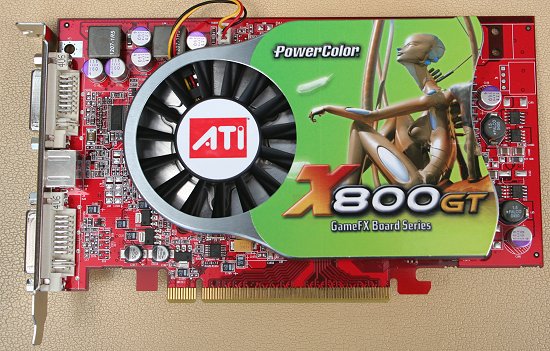
On initial appearance, the PowerColor X800 GT looks far more like the rest of the X800/850-series of cards than SAPPHIRE's version, although both use a similarly-sized PCB. The use of a larger cooler, red PCB, and dual-DVI-I outputs hint at its R480 heritage. Other differences include an off-centre cooling system that's favoured on high-end cards now. The general layout is reminiscent of PowerColor's own X800 XL range of cards.
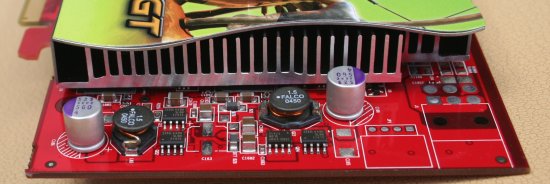
Half the rendering pipelines on a full X850-class SKU is highlighted the fact that the card doesn't carry the usual 6-pin PCIe power connector. The large aluminium heatsink would appear to cool the VPU and DRAM devices in one fell swoop, but this isn't quite the case. Stripping away the cooler reveals all.
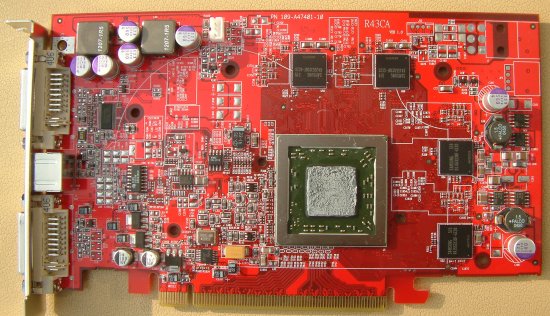
The VPU is surrounded by a small shim, typical of ATI's cards for a while now. The cooler rests on top and makes decent contact via a reasonable amount of thermal interface material (TIM). However, the 4 DRAM devices are not quite in contact with the heatsink, although this isn't a huge concern as PowerColor is specifying eight 256MBit 2ns-rated GDDR3 devices from Samsung with four on each side. As per X800 GT 256MB specification, DRAM is run at an effective 980MHz, through a 256-bit memory interface. That's around 32GB/s of potential bandwidth before we factor in the card's bandwidth-saving architecture.
PowerColor uses the same 70mm T&T 7010HH12C-NFC fan as found on its XL model. It's extremely quiet even when the card is placed under sustained 3D load, and it can't be heard in a reasonably quiet system. The heat absorbed by the heatsink is ducted away from the card, through the fins you see at the front, and into the case.
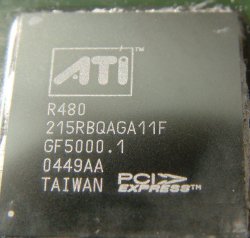
Cleaning off the TIM material shows us that we're dealing with an R480-class of VPU. PowerColor has bought a large chunk of ATI's cast-off inventory and will be using only R480 cores for its X800 GT. The performance advantages of, say, using R480 cores over R423s, as found on SAPPHIRE cards, is the possibility of better VPU overclocking.
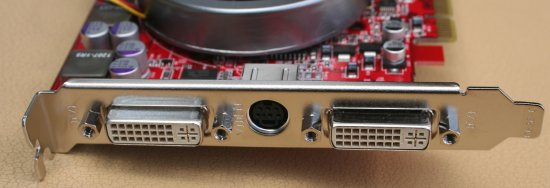
Dual-DVI-I outputs area definite bonus at the £110 price-point. The ability to connect 2 TFT displays via the preferred digital interface is becoming increasingly important as more and more users begin to evaluate the merits of a dual-display setup. The increase in interest has gone hand-in-hand with the continuing price drop of 17-to-19-inch LCD displays.

The rear of the card holds no secrets. There's no VIVO functionality on this model, but we wouldn't really expect it when the primary concern for a board partner is price above all else. The cooler's simply attached to the PCB by a small holding plate and a couple of screws.
A decent PCB design that's boosted by the use of a quiet fan, dual DVI-I outputs, and an R480 core.









